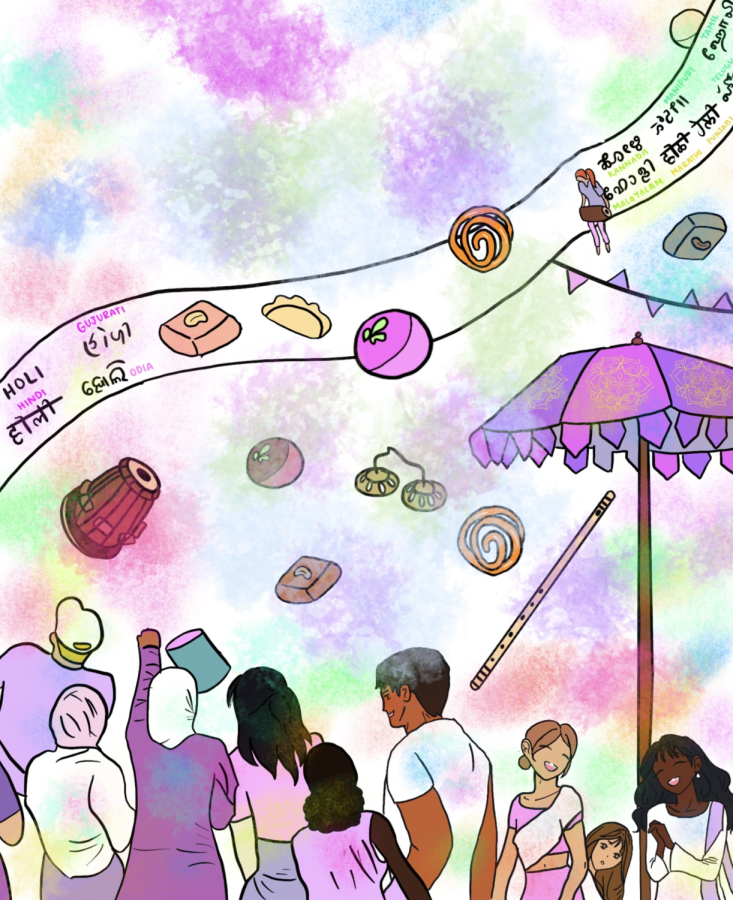Holi celebrations: Welcoming the blooming of the season
Vibrant colors soar as kids and adults fling “gulal,” or colored powder, at each other, their once white clothes dusted with colors of spring, resembling fields of flowers to welcome the new season. Also known as the Festival of Color, Holi is observed during March as a way to welcome spring and to honor the triumph of good over evil.
Vibrant colors soar as kids and adults fling “gulal,” or colored powder, at each other. Their once white clothes become dusted with colors of spring, resembling fields of flowers to welcome the new season. Unsuspecting participants soon find themselves drenched in water, and laughter fills the air.
Also known as the Festival of Color, Holi is observed during March as a way to welcome spring and to honor the triumph of good over evil. While mainly celebrated in India and Nepal, Holi celebrations also take place in many places across the world. During the festival, participants throw gulal at each other to symbolize the vibrancy of life.
For Saanvi Bhargava (10), Holi symbolizes joyousness, a celebration filled with people and colors. Normally, she celebrates Holi at home with her family and cousins, playing in the backyard with water balloons and gulal. Last year, her family attended a Holi celebration at Stanford University, getting involved in the local community.
“Holi, to me, means fun and a huge celebration of color,” Saanvi said. “I remember when I was younger, my family went to a Holi celebration with around a thousand people. It was so amazing to see so many people gathered to celebrate this holiday, and the music and food brought a lot of excitement.”
There are many different stories behind the origin of Holi. In many places in India, the festival is associated with the legend of the demon king Hiranyakashipu and his sister Holika. Holika attempted to kill Prahalad, a devotee of the Hindu god Vishnu, by burning him in a fire. Ultimately, she failed and ended up being consumed in the fire herself. This story represents the triumph of good over evil. While there are many legends behind the meaning of the holiday, it is also a way to greet spring.
“It’s a way of saying, ‘Oh, we’ve been in this bleak weather,’ so part of Holi is that spreading of colors to welcome the blooming of the season,” upper school math teacher Dr. Anu Aiyer said. “The powders represent those flowers through the colors.”
Other than the throwing of gulal, it is custom to light a bonfire that represents the burning of the demoness Holika. Other traditions include making “gujiyas,” which are dumpling-like desserts, filled with milk fudge and dry fruits. Many people also drink “thandai,” a spiced milk drink, and “rice kheer,” an Indian rice pudding.
I think I would say [good memories include] eating good food, especially some of the sweets,” Dr. Aiyer said. “It’s usually about people making elaborate things that you typically don’t make on a day to day basis, so it’s nice. Then, the other thing about Holi is that when I was a kid growing up in India, it was fun to celebrate.”
Whether a family celebrates Holi to welcome a new season, or to honor the good, different traditions allow people to appreciate the holiday. A holiday for all, Holi has various different meanings, but brings the same joy to all.
“Holi is a very colorful day where friends get together and just splash color on each other and enjoy themselves,” Anika Pallapothu (10) said. “It’s a great day to make memories with those around you whose company you enjoy. During Covid, it was depressing, but I was able to get together with friends and throw powder at them from far away, so the pandemic didn’t really stop me from celebrating.”

Vika Gautham (11) is the co-features editor for Harker Aquila and the Winged Post, and this is her third year on staff. This year, Vika wishes to provide...

Sarah Mohammed (12) is the co-editor-in-chief of the Winged Post, and this is her fourth year on staff. This year, she is excited to help make beautiful...

Ananya Sriram (12) is a co-managing editor for the Winged Post, and this is her fourth year on staff. This year, Ananya hopes to bond more with members...




![LALC Vice President of External Affairs Raeanne Li (11) explains the International Phonetic Alphabet to attendees. "We decided to have more fun topics this year instead of just talking about the same things every year so our older members can also [enjoy],” Raeanne said.](https://harkeraquila.com/wp-content/uploads/2025/10/DSC_4627-1200x795.jpg)


















![“[Building nerf blasters] became this outlet of creativity for me that hasn't been matched by anything else. The process [of] making a build complete to your desire is such a painstakingly difficult process, but I've had to learn from [the skills needed from] soldering to proper painting. There's so many different options for everything, if you think about it, it exists. The best part is [that] if it doesn't exist, you can build it yourself," Ishaan Parate said.](https://harkeraquila.com/wp-content/uploads/2022/08/DSC_8149-900x604.jpg)




![“When I came into high school, I was ready to be a follower. But DECA was a game changer for me. It helped me overcome my fear of public speaking, and it's played such a major role in who I've become today. To be able to successfully lead a chapter of 150 students, an officer team and be one of the upperclassmen I once really admired is something I'm [really] proud of,” Anvitha Tummala ('21) said.](https://harkeraquila.com/wp-content/uploads/2021/07/Screen-Shot-2021-07-25-at-9.50.05-AM-900x594.png)







![“I think getting up in the morning and having a sense of purpose [is exciting]. I think without a certain amount of drive, life is kind of obsolete and mundane, and I think having that every single day is what makes each day unique and kind of makes life exciting,” Neymika Jain (12) said.](https://harkeraquila.com/wp-content/uploads/2017/06/Screen-Shot-2017-06-03-at-4.54.16-PM.png)








![“My slogan is ‘slow feet, don’t eat, and I’m hungry.’ You need to run fast to get where you are–you aren't going to get those championships if you aren't fast,” Angel Cervantes (12) said. “I want to do well in school on my tests and in track and win championships for my team. I live by that, [and] I can do that anywhere: in the classroom or on the field.”](https://harkeraquila.com/wp-content/uploads/2018/06/DSC5146-900x601.jpg)
![“[Volleyball has] taught me how to fall correctly, and another thing it taught is that you don’t have to be the best at something to be good at it. If you just hit the ball in a smart way, then it still scores points and you’re good at it. You could be a background player and still make a much bigger impact on the team than you would think,” Anya Gert (’20) said.](https://harkeraquila.com/wp-content/uploads/2020/06/AnnaGert_JinTuan_HoHPhotoEdited-600x900.jpeg)

![“I'm not nearly there yet, but [my confidence has] definitely been getting better since I was pretty shy and timid coming into Harker my freshman year. I know that there's a lot of people that are really confident in what they do, and I really admire them. Everyone's so driven and that has really pushed me to kind of try to find my own place in high school and be more confident,” Alyssa Huang (’20) said.](https://harkeraquila.com/wp-content/uploads/2020/06/AlyssaHuang_EmilyChen_HoHPhoto-900x749.jpeg)



